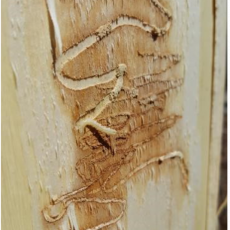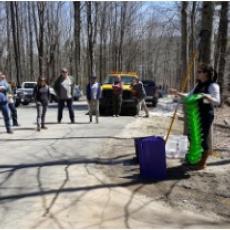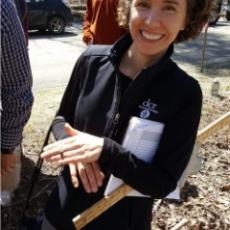DCR West Regional Office
740 South Street, Pittsfield, MA 01202
The Massachusetts Department of Agricultural Resources (MDAR) and the MA Department of Conservation and Recreation (DCR) co-hosted a daylong conference in Pittsfield, MA on 4/24/2018. What was the featured insect? Why, the emerald ash borer (Agrilus planipennis), of course! The emerald ash borer, or EAB for short, is a non-native insect (from Asia) that was first detected in the United States in Michigan in 2002.
The day-long conference on Tuesday was a combination of class-room style education and in-the-field demonstrations. Participants first heard about the history and a national overview of the “green menace” as referred to by Dr. Nate Siegert, a Forest Entomologist with the US Forest Service who has studied this insect since the very beginning in Michigan. Dr. Siegert discussed some of the reasons why New England, including Massachusetts, is a “hot-zone” for nonnative organisms, including invasive insects.
The long history of industrialization in New England, our diverse forests, and human-caused fragmentation of those forests are just a few of the factors that have helped facilitate the introduction and establishment of many non-native species in our region. In fact, it was mentioned that approximately 2.5 non-native species (on average) become established in the United States per year (Aukema et al. 2010). Since the 1970’s, an increase in the number of phloem and wood boring insects has been observed, likely due to the globalization of trade and the use of solid wood packing materials. Dr. Siegert discussed that since 2002, EAB has become the most destructive forest insect in North America. The impact of emerald ash borer is felt from unmanaged and managed forests to ornamental landscapes and urban forests. In fact, much of the burden of managing and dealing with (and paying for) emerald ash borer infestations is now being felt by municipalities faced with the reality of dead or dying ash trees.
Although there are multiple tools for detecting emerald ash borer that are now understood and available (this was not the case when the insect first arrived in the USA), reporting from professionals and the general public is still important. For example, the recent February 2018 detection of EAB in Vermont (for the first time) was made by a private forester who had attended trainings, such as this, and learned how to recognize the damage caused by the insect and where to report it.
Dr. Siegert discussed the “invasion wave” that is experienced as emerald ash borer enters communities. A tree can have EAB for 2-3 years before it is noticed. Around the 4th or 5th year from the initial infestation, damage is often noticeable. In a given location where EAB is present, by years 5-6, the population of the emerald ash borer increases exponentially, and pressure from the insect on ash trees in the area is heavy. 90% mortality of overstory ash is usually experienced by year 8-9. Dr. Siegert has also had the opportunity to study EAB population dynamics in areas where the insect has been present for over 15 years. He mentioned that by year 15, the EAB population drops to low levels, but does not disappear. Any ash that regenerates in the area will again become infested by the insect. If the pressure from the insect wasn’t difficult enough for our native ash, other factors such as deer browse heavily impact any remaining seedlings or stump sprouts in forested settings.
Nicole Keleher with the MA DCR’s Forest Health Program then spoke about EAB in Massachusetts. The insect was first detected on a purple panel trap monitored by the DCR in Dalton, MA in 2012. Since then, it has been detected in 31 communities in 8 counties in the state. The entire state of Massachusetts is now a part of the federal quarantine for EAB.
MA DCR surveys for EAB using various methods including the use of traps and lures ranging from purple panel traps to green funnel traps and trap trees. Trap trees are created by girdling trees, in areas where it is safe and permissible to do so, at DBH (diameter at breast height). Adult EAB, if they are in the area, are then attracted to the volatile chemicals released by the stressed tree. In the late winter or early spring, the trap trees are cut and their bark removed (peeled) to look for developing larvae. DCR also works with MDAR and volunteers using biosurveillance, which was discussed later in the program. Ms. Keleher encouraged the program participants to report any new finds of EAB to https://massnrc.org/pests/pestreports.htm .
MA DCR also assists federal programs by releasing biological controls in Massachusetts for the emerald ash borer. These include three species of tiny, non-stinging, parasitic wasps that are referred to by their scientific names: Oobius agrili, Tetrastichus planipennisi, and the newest one available, Spathius galinae. DCR has released these biocontrols at various locations in Massachusetts since 2014. They have released T. planipennisi and O. agrili at 11 locations in Berkshire, Essex, and Hampden counties. S. galinae was released by the MA DCR for the first time in Dalton, MA in 2017.
Mollie Freilicher with the DCR’s Urban and Community Forestry spoke about planning for forest pests and the importance of tree inventories. She highlighted the importance that communities and municipalities need to first think about what their own goals are for their urban forest in the presence of the emerald ash borer. Are your goals to maintain a safe urban forest? Spend the least amount of money? Preserve tree canopy and existing tree benefits? Maintain existing levels of ecosystem services provided by your urban forest? Perhaps increase funding for management? How about all of the above?
With those goals in mind, Ms. Freilicher guided participants through the process of conducting a tree inventory and what their communities can do with the information they collect to aid them in dealing with emerald ash borer, and certainly other forest pests. Tree inventories can include information about the location, size, species, condition, and other characteristics of a community’s tree resource in their urban forest. Communities can conduct a complete inventory, which includes information about all of the trees in their urban forest, or (if that is too daunting) they may get started with a partial inventory, which could be a random sampling, an inventory with a geographic focus (ex. town center or high-traffic parks), or in the case of EAB management: ash only. Tree inventories can help communities determine who is responsible for the health (or conversely, the removal) of trees in the urban forest and perhaps who they can share responsibility with (ex. utilities). Tree inventories also allow tree wardens to prioritize work. All of this is extremely valuable information to have when (before) facing emerald ash borer in your community.
Is your community interested in starting a tree inventory? Do you need help determining what data to collect and how to collect it (paper, smartphone, tablet, GPS)? DCR’s Urban and Community Forestry program may be able to help. Contact Mollie Freilicher for more information: mollie.freilicher@state.ma.us . Tree inventories can help communities when it comes time to make tough decisions in response to or in preparation for EAB:
- Remove and replace all ash?
- Remove some, treat some (buy time for removal)?
- Treat all trees in good/fair condition?
- Do nothing? (Not recommended, particularly for hazard trees.)
Ms. Freilicher emphasized that communities need to have a preparedness or response plan in place for dealing with EAB. This written document should outline the objectives and approaches to addressing and mitigating the impact of EAB on the urban forest. Not sure where to start? DCR provides a template for a preparedness or response plan here under Invasives, Insects, and Diseases.
Dr. Phil Lewis with the USDA Animal and Plant Health Inspection Service (Plant Protection and Quarantine) discussed insecticides and strategies for managing emerald ash borer in communities. While discussing these options, he highlighted lessons that have already been learned in states, such as Michigan, who have been living with emerald ash borer for many years. He emphasized the need for tree inventories, that managing emerald ash borer infested or killed trees can become the primary focus and draw resources from other projects in your community, that waiting to cut down infested trees until they are completely dead costs communities more, and that a lot of wood waste can be generated as a result of this insect.
Dr. Lewis discussed many chemical active ingredients that can be used to manage emerald ash borer, including but not limited to emamectin benzoate, imidacloprid, dinotefuran, and azadirachtin. He showed conference participants examples of the different methods for applying these active ingredients through injection, including using various pouches, capsules, syringes, pressure systems, and injection systems that are commercially available. An invaluable resource for industry professionals and landscape practitioners looking to manage emerald ash borer is: Insecticide Options for Protecting Ash Trees from Emerald Ash Borer by Herms et al. 2014.
Dr. Lewis also discussed the concept of using lethal trap trees as a management tool for emerald ash borer. These are trees that are first treated with an insecticide and then girdled to attract nearby emerald ash borer adults. The adult beetles may lay their eggs on the treated and girdled tree and the larvae, upon hatching and boring into the tree, are killed by the insecticide.
Finally, Dr. Lewis made a special mention of a relatively new (to the USA) invasive insect, the spotted lanternfly (Lycorma delicatula). He emphasized the need to recognize and report this insect. More information about the spotted lanternfly can be found here: http://ag.umass.edu/landscape/fact-sheets/spotted-lanternfly and any suspected spotted lanternfly should be reported here: https://massnrc.org/pests/pestreports.htm .
Dr. Jennifer Forman Orth with the Massachusetts Department of Agricultural Resources discussed using biosurveillance to monitor for the emerald ash borer. Biosurveillance is the act of using one organism to monitor for the presence of another. In this case, a native, ground-nesting and non-stinging wasp known as Cerceris fumipennis, or the smokey winged beetle bandit, is used to monitor for the emerald ash borer. Cerceris fumipennis is unable to sting humans; however, these wasps are experts at hunting down native (and non-native) beetles in the family Buprestidae (jewel beetles/flat-headed borers). This includes the emerald ash borer.
Dr. Forman Orth discussed using biosurveillance as a citizen science project, including with help from volunteers, to help communities look for the presence of EAB. Aggregations of these native, ground-nesting wasps can be monitored from July-August in Massachusetts to detect emerald ash borer and other species of interest, including the gold spotted oak borer (Agrilus auroguttatus) and the oak splendor beetle (A. biguttatus).
C. fumipennis prefers to nest in hard-packed, sandy soils with sparse grass or vegetation. Baseball fields, especially those that are not well maintained, make perfect locations to scout for the presence of these wasps. MDAR and volunteers have located over 300 sites across Massachusetts where this wasp exists. In 2017, C. fumipennis was used to detect emerald ash borer in two new communities: Waltham, MA (Middlesex county) and Georgetown, MA (Essex county). Anyone interested in volunteering with MDAR and participating with their biosurveillance program can sign up online: https://bit.ly/MassWaspWatchers . You can also follow @MassWaspWatchers on Facebook.
Javier Marin with the MA Department of Agricultural Resources ended the morning class-room style education with a moderated panel discussion. Participants were separated into two groups where they discussed their experiences with managing the emerald ash borer in towns where it is known to be in Massachusetts and challenges faced.
Following lunch, conference participants gathered outside for field-based demonstrations. Ken Gooch with DCR Forest Health reviewed the identification of ash trees and showed participants actual EAB damage in an infested tree at the conference location in Pittsfield, MA. Participants were shown the signs and symptoms of an EAB infestation, including blonding caused by woodpecker feeding, epicormic shoots, D-shaped exit holes, S-shaped galleries beneath the bark, and live EAB larvae were viewed, freshly removed from infested trees. Mr.
Gooch also showed participants how to girdle an ash tree to create a trap tree. Nicole Keleher demonstrated how to use and hang purple panel and green funnel traps to detect emerald ash borer. Mollie Freilicher gave a tree inventory demonstration and Phil Lewis demonstrated how to inject an ash tree with an insecticide.
The conference was a great learning experience, and a great example of local, state, and federal cooperation in the face of the “green menace”.
Wishing you could have attended? UMass Extension and the MA Department of Conservation and Recreation will be co-hosting a similar training in September 2018. Keep an eye out for an announcement here: https://ag.umass.edu/landscape/upcoming-events .
Reported by Tawny Simisky, Extension Entomologist, UMass Extension Landscape, Nursery, & Urban Forestry Program
Photo Captions: 1) Emerald ash borer galleries and larva viewed at the training. 2) Ken Gooch showing participants the damage caused by emerald ash borer larval feeding. 3) Nicole Keleher showing participants how to hang a green funnel trap to detect EAB. 4) Phil Lewis demonstrating a trunk injection to manage EAB. 5) Mollie Freilicher holding a native wood boring beetle (Dicerca spp.) found during the field portion of the training. 6) Nate Siegert discussing the biology of the emerald ash borer. (Simisky, 2018)





